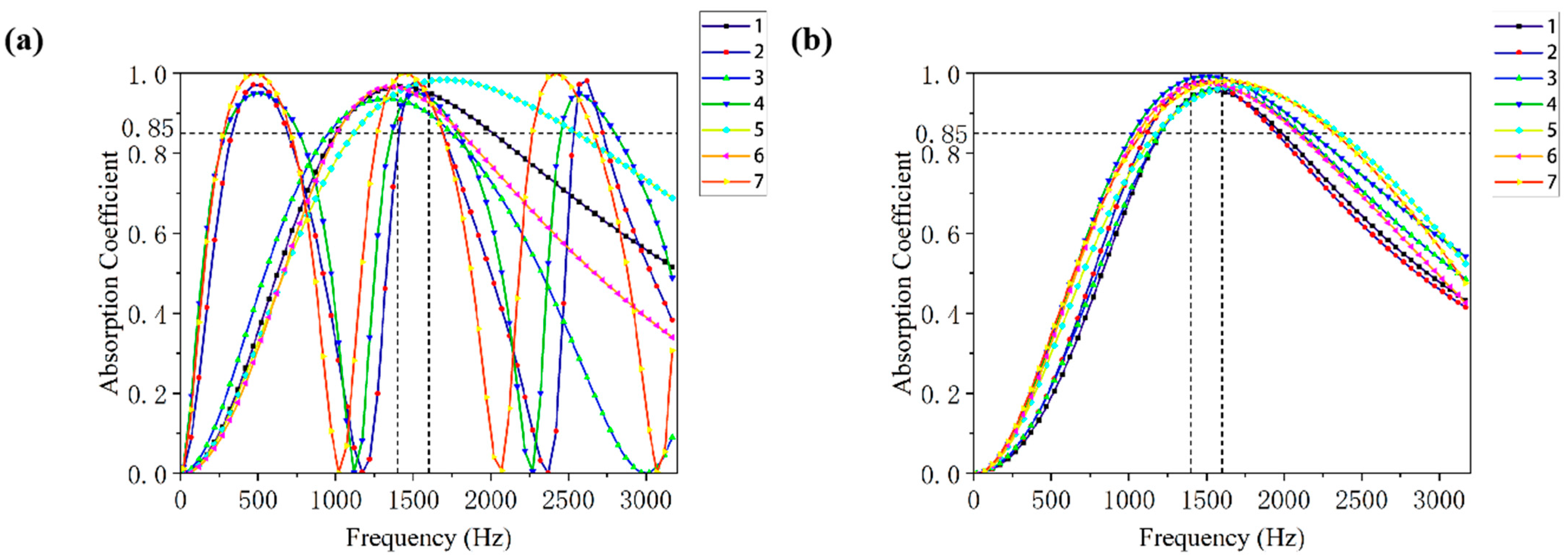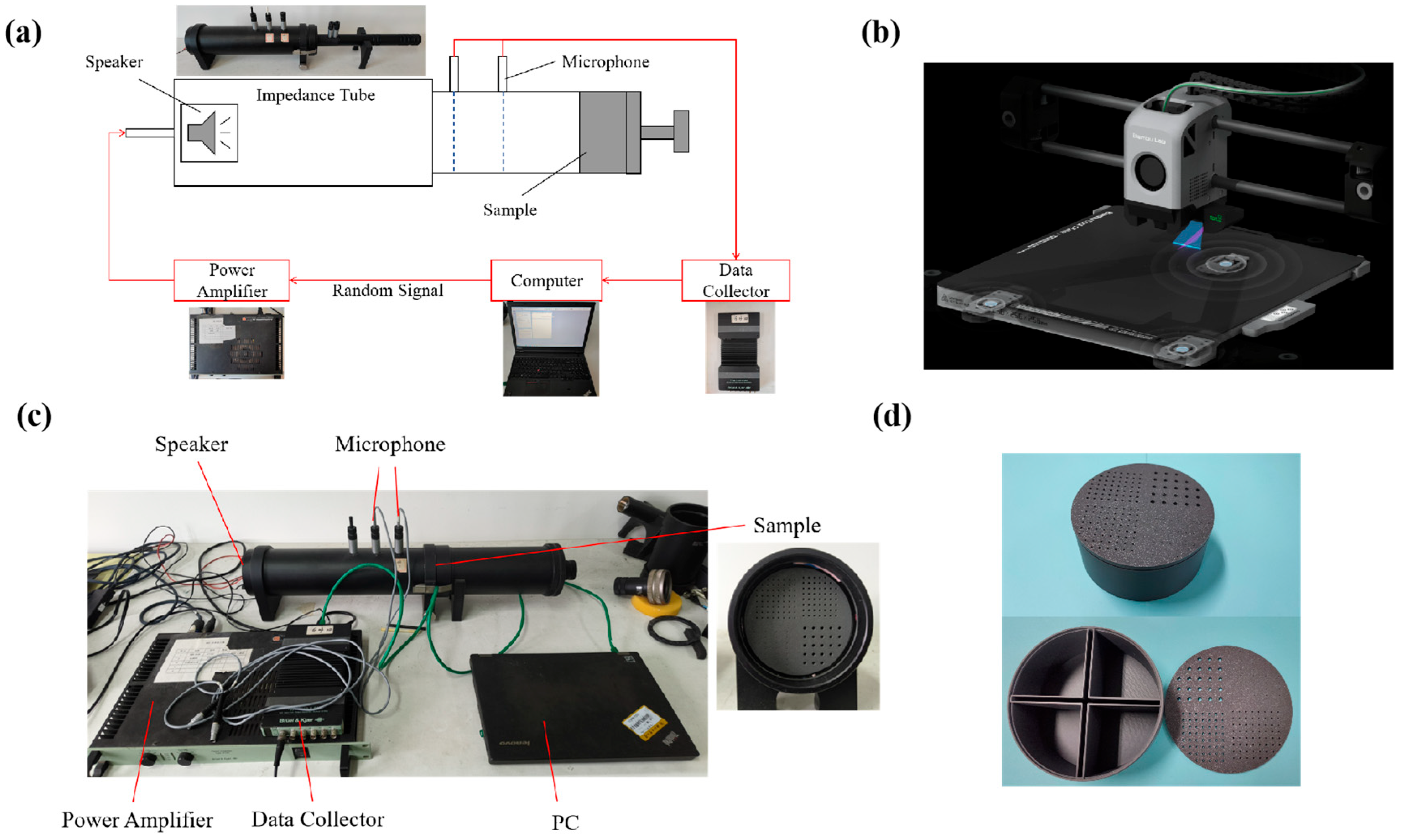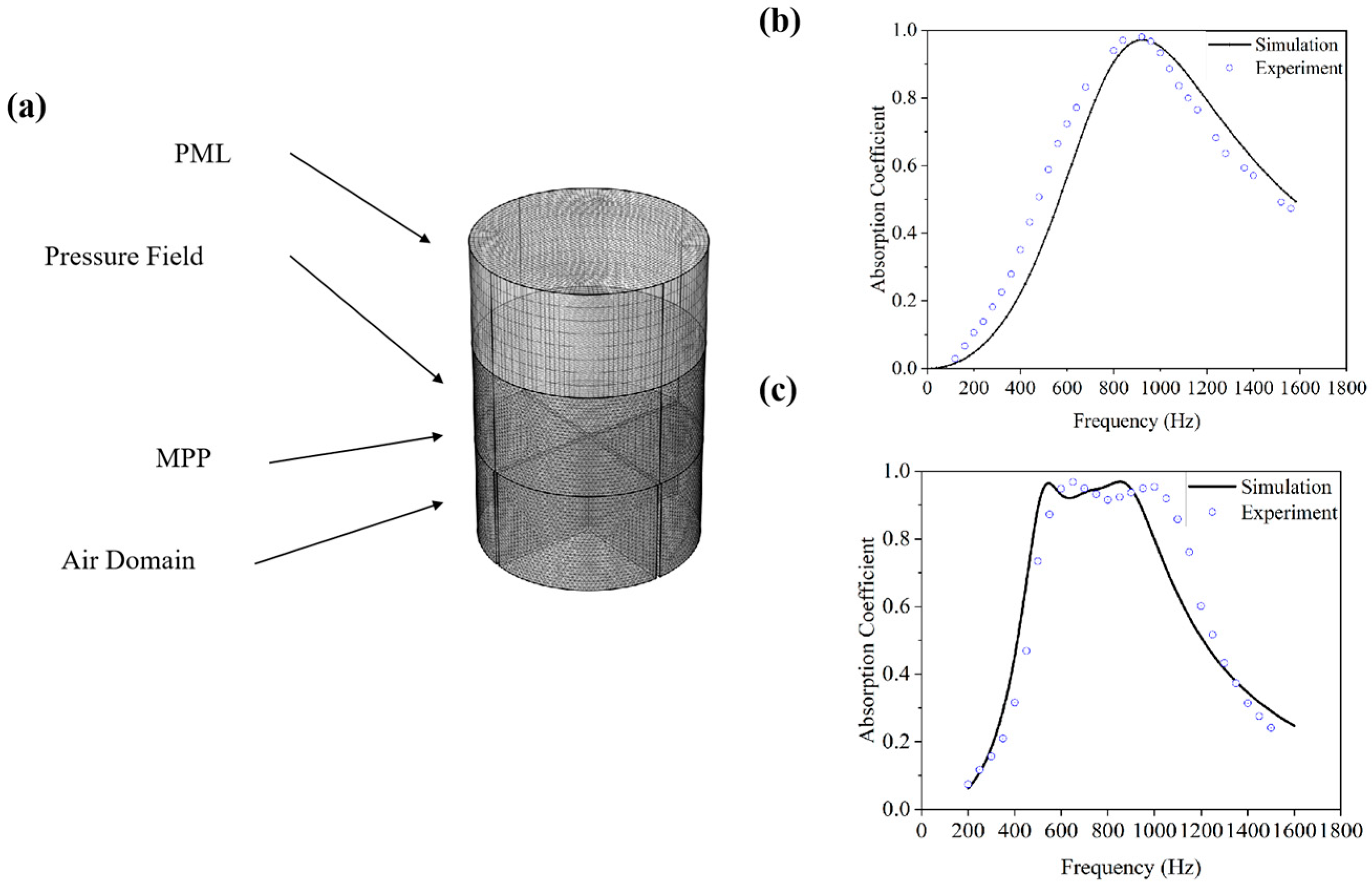Accelerated Inverse Design of Multi-Parallel Microperforated Panel Absorbers via Physics-Informed Neural Networks
Abstract
1. Introduction
2. Methods
2.1. Establishment of the Dataset for the MPP
2.2. Inverse Design Networks
3. Results and Verification
3.1. Results of Inverse Design Networks
3.2. Design of MPP and Verification
4. Discussion
5. Conclusions
Supplementary Materials
Author Contributions
Funding
Data Availability Statement
Acknowledgments
Conflicts of Interest
References
- Cao, L.T.; Fu, Q.X.; Si, Y.; Ding, B.; Yu, J.Y. Porous Materials for Sound Absorption. Compos. Commun. 2018, 10, 25–35. [Google Scholar] [CrossRef]
- Yang, M.; Sheng, P. Sound Absorption Structures: From Porous Media to Acoustic Metamaterials. Annu. Rev. Mater. Res. 2017, 47, 83–114. [Google Scholar] [CrossRef]
- Arunkumar, M.P.; Pitchaimani, J.; Gangadharan, K.V.; Leninbabu, M.C. Vibro-acoustic Response and Sound Transmission Loss Characteristics of Truss Core Sandwich Panel Filled with Foam. Aerosp. Sci. Technol. 2018, 78, 1–11. [Google Scholar] [CrossRef]
- Du, J.J.; Fu, G.W.; Xu, X.; Elshahawy, A.M.; Guan, C. 3D Printed Graphene-Based Metamaterials: Guesting Multi-Functionality in One Gain. Small 2023, 19, 2207833. [Google Scholar] [CrossRef]
- Zhang, H.K.; Chen, W.T.; Xu, S.H.; Wu, J.; Li, B.; Feng, X.Q. Active topological phase transitions in high-order elastic topological insulators driven by pneumatic methods and liquid metals. J. Appl. Phys. 2023, 133, 104504. [Google Scholar] [CrossRef]
- Li, Y.; Ning, W.; Peng, Q.Y.; Yang, M.L.; Lei, D.Y.; Guo, S.Y.; Liu, P.; Jiang, K.L.; He, X.D.; Li, Y.B. Superbroad-band Actively Tunable Acoustic Metamaterials Driven from Poly (ethylene terephthalate)/Carbon Nanotube Nanocomposite Membranes. Nano Res. 2021, 14, 100–107. [Google Scholar] [CrossRef]
- Guo, J.W.; Zhang, X.; Fang, Y.; Jiang, Z.Y. A Compact Low-frequency Sound-absorbing Metasurface Constructed by Resonator with Embedded Spiral Neck. Appl. Phys. Lett. 2020, 117, 221902. [Google Scholar] [CrossRef]
- Cai, X.B.; Guo, Q.Q.; Hu, G.K.; Yang, J. Ultrathin Low-frequency Sound Absorbing Panels Based on Coplanar Spiral Tubes or Coplanar Helmholtz Resonators. Appl. Phys. Lett. 2014, 105, 121901. [Google Scholar] [CrossRef]
- Wang, Y.; Zhao, H.G.; Yang, H.B.; Zhong, J.; Wen, J.H. A Space-coiled Acoustic Metamaterial with Tunable Low-frequency Sound Absorption. Europhys. Lett. 2017, 120, 54001. [Google Scholar] [CrossRef]
- Frenzel, T.; Brehm, J.D.; Bückmann, T.; Schittny, R.; Kadic, M.; Wegener, M. Three-dimensional Labyrinthine Acoustic Metamaterials. Appl. Phys. Lett. 2013, 103, 61907. [Google Scholar] [CrossRef]
- Xiao, Z.Q.; Gao, P.L.; Wang, D.W.; He, X.; Wu, L.Z. Ventilated Metamaterials for Broadband Sound Insulation and Tunable Transmission at Low Frequency. Extrem. Mech. Lett. 2021, 46, 101348. [Google Scholar] [CrossRef]
- Chen, Y.Y.; Huang, G.L.; Zhou, X.M.; Hu, G.K.; Sun, C.T. Analytical Coupled Vibroacoustic Modeling of Membrane-type Acoustic Metamaterials: Membrane Model. J. Acous. Soc. Am. 2014, 136, 969. [Google Scholar] [CrossRef]
- Mei, J.; Ma, G.C.; Yang, M.; Yang, Z.Y.; Wen, W.J.; Sheng, P. Dark Acoustic Metamaterials as Super Absorbers for Low-frequency Sound. Nat. Commun. 2012, 3, 756. [Google Scholar] [CrossRef] [PubMed]
- Jin, J.; Huang, J.; Xiao, Y. Realization of Nonreciprocal Acoustic Energy Transfer Using an Asymmetric Strong Nonlinear Vibroacoustic System. Int. J. Mech. Syst. Dyn. 2024, 4, 99–114. [Google Scholar] [CrossRef]
- Maa, D.-Y. Microperforated-panel Wideband Absorbers. Noise Control Eng. J. 1987, 29, 77–84. [Google Scholar] [CrossRef]
- Dah-You, M. Potential of Microperforated Panel Absorber. J. Acous. Soc. Am. 1998, 104, 2861–2866. [Google Scholar] [CrossRef]
- Kim, S.; Kim, Y.H.; Jang, J.H. A Theoretical Model to Predict the Low-frequency Sound Absorption of a Helmholtz Resonator Array (L). J. Acous. Soc. Am. 2006, 119, 1933–1936. [Google Scholar] [CrossRef]
- Maa, D.-Y. Theory and Design of Microperforated Panel Sound-absorbing Sconstructions. Sci. Sin. 1975, 18, 55–71. [Google Scholar]
- Prydz, R.A.; Wirt, L.S.; Kuntz, H.L.; Pope, L.D. Transmission Loss of a Multilayer Panel with Internal Tuned Helmholtz Resonators. J. Acous. Soc. Am. 1990, 87, 1597–1602. [Google Scholar] [CrossRef]
- Jeon, J.H.; Yang, S.S.; Kang, Y.J. Estimation of Sound Absorption Coefficient of Layered Fibrous Material Using Artificial Neural Networks. Appl. Acoust. 2020, 169, 107476. [Google Scholar] [CrossRef]
- Iannace, G.; Ciaburro, G.; Trematerra, A. Modelling Sound Absorption Properties of Broom Fibers Using Artificial Neural Networks. Appl. Acoust. 2020, 163, 107239. [Google Scholar] [CrossRef]
- Huang, X.R.; Huang, H.B.; Wu, J.H.; Yang, M.L.; Ding, W.P. Sound Quality Prediction and Improving of Vehicle Interior Noise Based on Deep Convolutional Neural Networks. Expert Syst. Appl. 2020, 160, 113657. [Google Scholar] [CrossRef]
- Xiao, Z.Q.; Gao, P.L.; Wang, D.W.; He, X.; Qu, Y.G.; Wu, L.Z. Accelerated Design of Low-frequency Broadband Sound Absorber with Deep Learning Approach. Mech. Syst. Signal Proc. 2024, 211, 111228. [Google Scholar] [CrossRef]
- Zhao, D.D.; Dong, H.W.; Gu, Y.; Qu, W.Z.; Zhao, S.D. Inverse-designed Acoustic Metasurfaces for Broadband Sound Absorption. J. Appl. Phys. 2024, 136, 164901. [Google Scholar] [CrossRef]
- Cho, M.W.; Hwang, S.H.; Jang, J.Y.; Song, J.Y.; Hwang, S.K.; Cha, K.J.; Park, D.Y.; Song, K.; Park, S.M. Inverse Design of Nanoporous Crystalline Reticular Materials with Deep Generative Models. Nat. Mach. Intell. 2021, 3, 76–86. [Google Scholar] [CrossRef]
- Xiao, L.; Cao, Z.G.; Lu, H.R.; Cai, Y.Q. Controllable and Scalable Gradient-driven Optimization Design for Two-dimensional Metamaterials Based on Deep Learning. Compos. Struct. 2024, 337, 118072. [Google Scholar] [CrossRef]
- Khatib, O.; Ren, S.M.; Malof, J.; Padilla, W.J. Deep Learning the Electromagnetic Properties of Metamaterials-A Comprehensive Review. Adv. Funct. Mater. 2021, 31, 2101748. [Google Scholar] [CrossRef]
- Goh, G.B.; Hodas, N.O.; Vishnu, A. Deep Learning for Computational Chemistry. J. Comput. Chem. 2017, 38, 1291–1307. [Google Scholar] [CrossRef] [PubMed]
- Zahavy, T.; Dikopoltsev, A.; Moss, D.; Haham, G.I.; Cohen, O.; Mannor, S.; Segev, M. Deep Learning Reconstruction of Ultrashort Pulses. Optica 2018, 5, 666–673. [Google Scholar] [CrossRef]
- Krizhevsky, A.; Sutskever, I.; Hinton, G.E. ImageNet Classification with Deep Convolutional Neural Networks. Commun. ACM 2017, 60, 84–90. [Google Scholar] [CrossRef]
- Sanchez-Lengeling, B.; Aspuru-Guzik, A. Inverse Molecular Design Using Machine Learning: Generative Models for Matter Engineering. Science 2018, 361, 360–365. [Google Scholar] [CrossRef]
- Carrasquilla, J.; Melko, R.G. Machine Learning Phases of Matter. Nat. Phys. 2017, 13, 431–434. [Google Scholar] [CrossRef]
- Silver, D.; Huang, A.; Maddison, C.J.; Guez, A.; Sifre, L.; van den Driessche, G.; Schrittwieser, J.; Antonoglou, I.; Panneershelvam, V.; Lanctot, M.; et al. Mastering the Game of Go with Deep Neural Networks and tree search. Nature 2016, 529, 484. [Google Scholar] [CrossRef]
- Henkes, A.; Wessels, H.; Mahnken, R. Physics Informed Neural Networks for Continuum Micromechanics. Comput. Meth. Appl. Mech. Eng. 2022, 393, 114790. [Google Scholar] [CrossRef]
- Shen, S.; Lu, H.; Sadoughi, M.; Hu, C.; Nemani, V.; Thelen, A.; Webster, K.; Darr, M.; Sidon, J.; Kenny, S. A Physics-informed Deep Learning Approach for Bearing Fault Detection. Eng. Appl. Artif. Intell. 2021, 103, 104295. [Google Scholar] [CrossRef]
- Xu, Y.W.; Kohtz, S.; Boakye, J.; Gardoni, P.; Wang, P.F. Physics-informed Machine Learning for Reliability and Systems Safety Applications: State of the Art and Challenges. Reliab. Eng. Syst. Saf. 2023, 230, 108900. [Google Scholar] [CrossRef]
- Jagtap, A.D.; Mao, Z.P.; Adams, N.; Karniadakis, G.E. Physics-informed Neural Networks for Inverse Problems in Supersonic Flows. J. Comput. Phys. 2022, 466, 111402. [Google Scholar] [CrossRef]
- Meng, X.H.; Li, Z.; Zhang, D.K.; Karniadakis, G.E. PPINN: Parareal Physics-informed Neural Network for Time-dependent PDEs. Comput. Meth. Appl. Mech. Eng. 2020, 370, 113250. [Google Scholar] [CrossRef]
- Almajid, M.M.; Abu-Al-Saud, M.O. Prediction of Porous Media Fluid Flow Using Physics Informed Neural Networks. J. Pet. Sci. Eng. 2022, 208, 109205. [Google Scholar] [CrossRef]
- Cuomo, S.; Di Cola, V.S.; Giampaolo, F.; Rozza, G.; Raissi, M.; Piccialli, F. Scientific Machine Learning Through Physics-Informed Neural Networks: Where we are and What’s Next. J. Sci. Comput. 2022, 92, 88. [Google Scholar] [CrossRef]
- Ma, J.; Huang, Y.J.; Pu, M.B.; Xu, D.; Luo, J.; Guo, Y.H.; Luo, X.A. Inverse Design of Broadband Metasurface Absorber Based on Convolutional Autoencoder Network and Inverse Design Network. J. Phys. D-Appl. Phys. 2020, 53, 464002. [Google Scholar] [CrossRef]
- Hanakata, P.Z.; Cubuk, E.D.; Campbell, D.K.; Park, H.S. Forward and Inverse Design of Kirigami via Supervised Autoencoder. Phys. Rev. Res. 2020, 2, 042006. [Google Scholar] [CrossRef]
- Tang, Y.H.; Kojima, K.; Koike-Akino, T.; Wang, Y.; Wu, P.X.; Xie, Y.Y.; Tahersima, M.H.; Jha, D.K.; Parsons, K.; Qi, M.H. Generative Deep Learning Model for Inverse Design of Integrated Nanophotonic Devices. Laser Photon. Rev. 2020, 14, 2000287. [Google Scholar] [CrossRef]
- Yonekura, K.; Suzuki, K. Data-driven Design Exploration Method Using Conditional Variational Autoencoder for Airfoil Design. Struct. Multidiscip. Optim. 2021, 64, 613–624. [Google Scholar] [CrossRef]
- Khoshaman, A.; Vinci, W.; Denis, B.; Andriyash, E.; Amin, M.H. Quantum variational autoencoder. Quantum Sci. Technol. 2019, 4, 014001. [Google Scholar] [CrossRef]
- Wang, Y.S.; Yao, H.X.; Zhao, S.C. Auto-encoder based Dimensionality Reduction. Neurocomputing 2016, 184, 232–242. [Google Scholar] [CrossRef]
- Liang, R.H.; Liu, W.F.; Fu, Y.G.; Ma, M. Physics-informed Deep Learning for Structural Dynamics under Moving Load. Int. J. Mech. Sci. 2024, 284, 109766. [Google Scholar] [CrossRef]






| Character | Description | Value | Unit |
|---|---|---|---|
| Sound absorption coefficient | |||
| Characteristic impedance of air | Pa·s/m | ||
| Surface impedance at MPP inlet | Pa·s/m | ||
| Microporous impedance | Pa·s/m | ||
| Acoustic impedance of the rear cavity | Pa·s/m | ||
| Acoustic impedance of single MPP absorber | Pa·s/m | ||
| Acoustic resistance component | Pa·s/m | ||
| Perforation rate | |||
| Resistance coefficient | |||
| Acoustic mass | kg/m2 | ||
| Angular frequency | rad/s | ||
| Mass reactance coefficient | |||
| Dynamic viscosity of air | 1.81 × 10−5 | Pa·s | |
| Panel thickness | 0.1–10 | mm | |
| Hole diameter | 0.1–3 | mm | |
| Perforation constant | |||
| Cavity depth | 1–150 | mm | |
| Sound speed in air | 343 | m/s | |
| Air density | 1.21 | kg/m3 | |
| Sound frequency | 50–1600 | Hz | |
| Diameter of metamaterial acoustic cavity | 100 | mm | |
| Reconstruction loss | |||
| Kullback-Leibler divergence | |||
| Physics constraint loss | |||
| Data fidelity loss | |||
| Adaptive weighting coefficients |
| Single VAE | VAE with PINN | ||||||
|---|---|---|---|---|---|---|---|
| [mm] | [mm] | [mm] | [mm] | [mm] | [mm] | ||
| 1.7 | 0.037 | 1.0 | 30 | 2.3 | 0.038 | 0.80 | 31 |
| 2.1 | 0.047 | 1.0 | 150 | 2.0 | 0.013 | 0.23 | 31 |
| 1.2 | 0.10 | 5.8 | 57 | 2.0 | 0.041 | 0.70 | 33 |
| 1.1 | 0.071 | 9.1 | 150 | 1.7 | 0.048 | 0.99 | 32 |
| 1.4 | 0.026 | 3.4 | 31 | 1.3 | 0.12 | 0.97 | 39 |
| 2.1 | 0.047 | 8.7 | 39 | 1.3 | 0.084 | 0.64 | 42 |
| 1.1 | 0.11 | 9.3 | 170 | 1.7 | 0.072 | 0.93 | 40 |
| Model | RMS | Relative Error |
|---|---|---|
| Single VAE | 0.186 | 12.7% |
| VAE with PINN | 0.043 | 3.2% |
| Hole Diameter, [mm] | Panel Thickness, [mm] | Cavity Depth, [mm] | |
|---|---|---|---|
| 0.6 | 0.001 | 1 | 45 |
| 1 | 0.006 | 1 | 45 |
| 2 | 0.02 | 1 | 45 |
| 3 | 0.02 | 1 | 45 |
| Reference | Research Objective | Method |
|---|---|---|
| Xiao et al. [23] | Accelerate low-frequency broadband absorber design | Autoencoder-like neural network with probabilistic model |
| Zhao et al. [24] | Inverse design of acoustic metasurfaces for broadband absorption | Topology-optimized inverse design approach |
| Cho et al. [25] | Inverse design of ventilated acoustic resonators | Acoustic response-encoded variational autoencoder |
| Xiao et al. [26] | Controllable optimization of 2D metamaterials | Novel gradient-driven rapid optimization design method |
| Our study | Accelerated inverse design of multi-parallel MPP via VAE and PINN | Variational autoencoder with physics-informed neural networks |
Disclaimer/Publisher’s Note: The statements, opinions and data contained in all publications are solely those of the individual author(s) and contributor(s) and not of MDPI and/or the editor(s). MDPI and/or the editor(s) disclaim responsibility for any injury to people or property resulting from any ideas, methods, instructions or products referred to in the content. |
© 2025 by the authors. Licensee MDPI, Basel, Switzerland. This article is an open access article distributed under the terms and conditions of the Creative Commons Attribution (CC BY) license (https://creativecommons.org/licenses/by/4.0/).
Share and Cite
Jiang, L.; Cao, B.; Huang, A.; Yao, L.; Jin, J. Accelerated Inverse Design of Multi-Parallel Microperforated Panel Absorbers via Physics-Informed Neural Networks. Appl. Sci. 2025, 15, 11955. https://doi.org/10.3390/app152211955
Jiang L, Cao B, Huang A, Yao L, Jin J. Accelerated Inverse Design of Multi-Parallel Microperforated Panel Absorbers via Physics-Informed Neural Networks. Applied Sciences. 2025; 15(22):11955. https://doi.org/10.3390/app152211955
Chicago/Turabian StyleJiang, Liyang, Bohan Cao, Ao Huang, Lei Yao, and Jiangming Jin. 2025. "Accelerated Inverse Design of Multi-Parallel Microperforated Panel Absorbers via Physics-Informed Neural Networks" Applied Sciences 15, no. 22: 11955. https://doi.org/10.3390/app152211955
APA StyleJiang, L., Cao, B., Huang, A., Yao, L., & Jin, J. (2025). Accelerated Inverse Design of Multi-Parallel Microperforated Panel Absorbers via Physics-Informed Neural Networks. Applied Sciences, 15(22), 11955. https://doi.org/10.3390/app152211955






